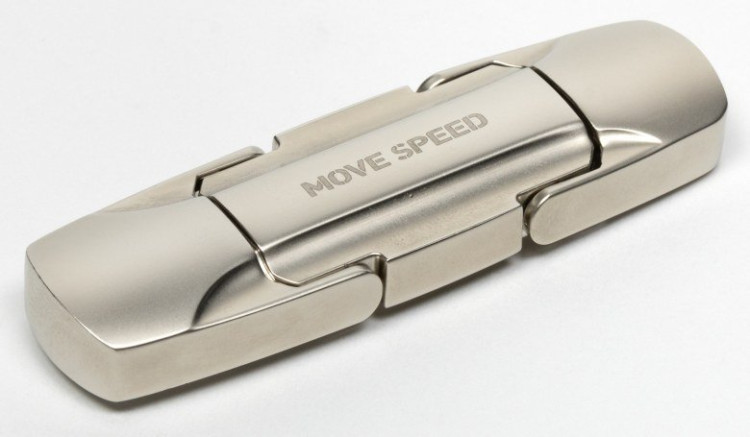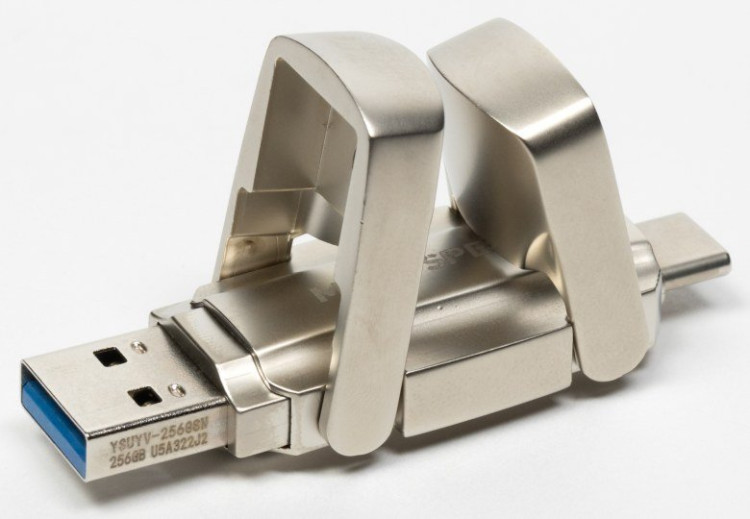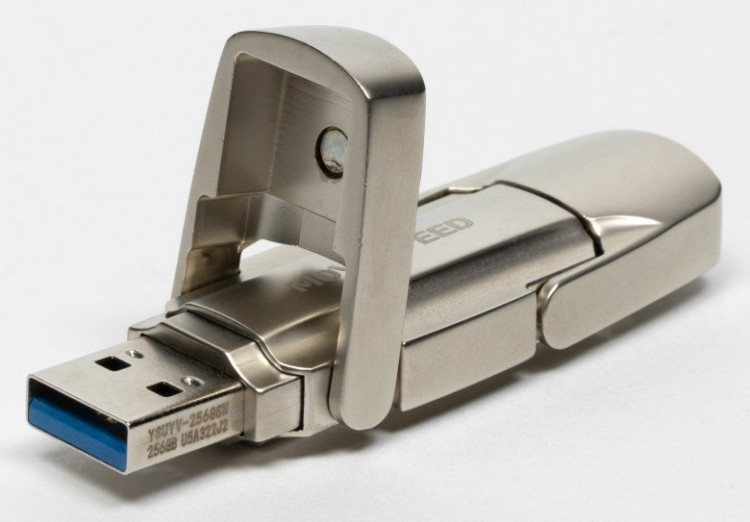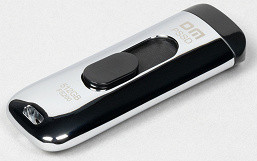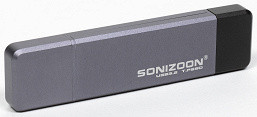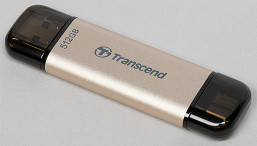In recent years, USB flash drives have become less relevant due to the development of global networks and the emergence of external SSDs. However, they still find use in specific areas such as operating system installation. With the advent of external SSDs up to 8 TB and M.2 2280, USB flash drives are considered less necessary. Some manufacturers have begun packaging external SSDs in flash enclosures or using UFS drives with a USB-to-UFS bridge to create «mega-flash drives.» However, there are also USB flash drives with controllers similar to those for SSDs, which blurs the boundaries between these products. For example, Kingston released the DataTraveler Max flash drive, which uses the same controller as their external SSDs but is packaged in a standard flash drive enclosure. This allows you to do without additional bridges and make the device compact. While the USB flash drive market may be too small for big brands, you can find interesting products from smaller manufacturers on AliExpress.
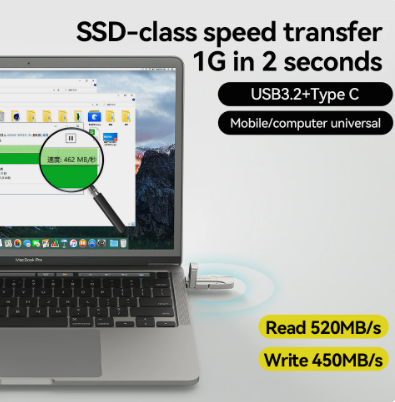
The purchase was made under the impression of the promised characteristics. The exact speed parameters in such cases often remain a question, but persistent mentions of USB 3.2 support and Gen2 speeds pointed to the possibility that this was an external SSD hidden in the body of a USB flash drive. The JMS901 controller does not support such speeds, being limited to the older USB 3.0 standard. On the other hand, manufacturers often promise speeds of 550 MB/s for SATA devices, which is usually demonstrated by tests like CrystalDiskMark, therefore, there was a chance of encountering a controller for high-speed USB flash drives. The design of the device attracted attention, and the price, considering the characteristics discussed, seemed reasonable. Therefore, it was decided to place an order and personally evaluate the product. Delivery from China took only a week thanks to the Pyaterochka service, so the wait was short and pleasant compared to previous experiences of slow delivery. The device obtained from the parcel terminal was subjected to careful study, and we will describe in detail what came out of it below. You can judge for yourself whether the purchase was worth it.
MoveSpeed 2 in 1 USB Flash Drive 256 GB
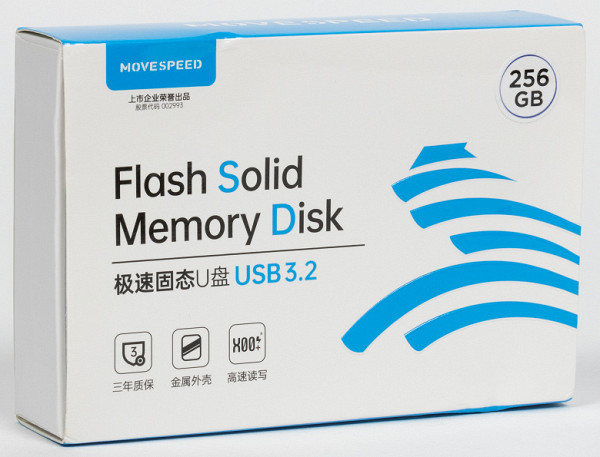
It's an impressive, nice box — at least put it on a shelf in a supermarket.
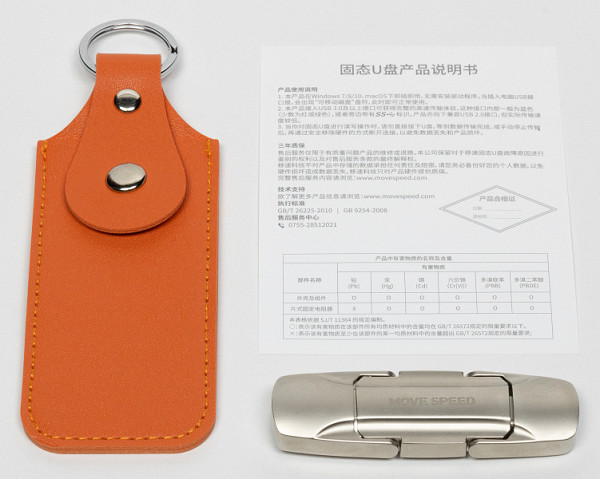
The flash drive also came with a “gift” case designed for conveniently carrying the device along with your keys. Although the case was not officially included in the package, it was added as an addition. This careful attention to the user's needs deserves special recognition, especially considering the lack of special mounts on the device itself.
The design of the device is so elegant that it could easily be put on display. Forget about lost caps and wobbly sliders. The protective covers for the connectors simply fold back, leaving one of two connectors available to the user — the one he needs at the moment. The presence of two connectors guarantees wide compatibility with various devices, except, perhaps, older phone models with a Micro-USB port. Although, it is worth noting that Micro-USB can still be found in some modern budget smartphones, but their users are unlikely to want to purchase a flash drive for half the cost of their phone. A description of the device's appearance can be found in the gallery. Maximum folded dimensions are 70x20x11 mm, weight — 35 g, although the specification indicates 37.7 g, which may refer to versions with a larger capacity.
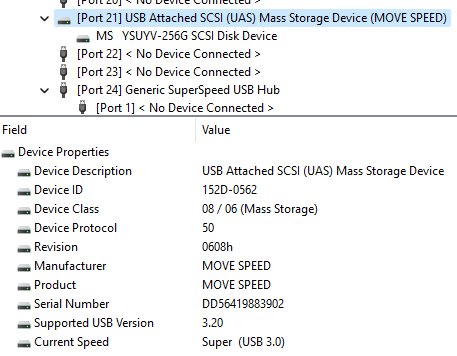
Although the appearance is attractive, the main thing for us is the characteristics. The first thing that is alarming is the way the device is identified by the system: even in the USB 3.2 Gen2x2 port to exclude any interference, we only see the SuperSpeed mode, and this is Gen1, known as USB 3.0. This means that the maximum this flash drive is capable of is far from the promised 520 MB/s, but most likely about 460 MB/s at best. The VID/PIDs hint at the use of JMicron's decade-old JMS562 USB-to-SATA bridge, which supports USB 3.0 but is designed for two SATA devices, which seems unusual. However, with JMicron everything is possible: the firmware can be customized to your liking, which is reflected in the identification of the device. An example of this situation has already happened with Orico and their products based on JMicron JMS901. This is confirmed by the inability of a flash drive to work with utilities like CrystalDiskInfo, which is not typical for USB-SATA and USB-NVMe bridges, as well as for many modern controllers.
Mixed feelings from this discovery. On the one hand, the obvious exaggeration regarding USB3 Gen2 and speeds in the specifications is disappointing. On the other hand, it is difficult to understand why this exaggeration was made: an honest mention of UFS would not raise questions. Yes, perhaps the speeds would be a little slower. But the unique design could be enough of a purchase incentive for many, since the difference between 460 and 520 MB/s in practice is small. Moreover, the write speeds of UFS devices are often faster than many available external SSDs. Interestingly, the MoveSpeed firmware has a unique feature: this is the first UFS drive we have encountered with a working Trim function, which is an undoubted advantage and a reason for additional testing. Previously, we tested a similar device with only 512 GB, but here we tested it with half that capacity, but with Trim support, which may also indicate effective SLC caching. This gives reason for deeper testing of the device, given the presence of this function.
Testing
Samples for comparison
Today we will not compare our drive with full-fledged external SSDs or portable HDDs, since it is known that SSDs will work faster, and HDDs will be much slower. We have made these comparisons in the past. Let's focus on three devices that are perceived by most buyers as flash drives: DM Portable SSD FS200, Sonizoon USB3.1 P.SSD and Transcend JetFlash 930C. The first and last offer 512 GB of memory, while the second offers half as much, but is also the most expensive option. The FS200 stands out for its lowest price, but only has one USB port and doesn't support Trim. Transcend, on the other hand, is more familiar to a wider audience and has its loyal fans, despite the fact that it uses a typical, not the latest flash memory controller, although it does not skimp on memory quality. Thus, at first glance it is difficult to determine which option is better to purchase. However, you can determine which one is faster by taking simple measurements.
Filling with data
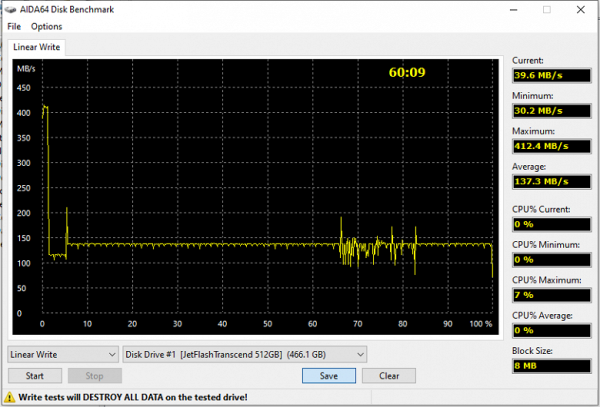
SLC caching has long been commonplace for flash memory controllers, but until recently they were not very diverse in their caching strategies. The Transcend JetFlash 930C model uses a Silicon Motion SM3282 controller, which provides a static cache of 15 GB regardless of the size of the drive itself. At the time the controller was created, this cache size was considered quite impressive and could satisfy the needs not only for storing small files. After testing some budget external QLC SSDs where write speeds could drop to 20-30 MB/s, the 150 MB/s write speed offered here seems quite attractive compared to most volumes. While the cache can be used to confuse benchmark programs like CrystalDiskMark, it is perfectly acceptable.

It is worth noting that many UFS drives, including the DM Portable SSD FS200, at first glance seem hardly better. However, as already noted, the main problem lies not so much in the hardware, but in the inferior implementation of Trim. This, in turn, affects the efficiency of SLC caching. As a result, only a small static cache area remains, which the controller clears on its own, and the rest of the volume is constantly overwritten, instead of using “free” cells. However, even under these conditions, the speed is slightly higher than that of the 930C, even taking into account all the limitations.
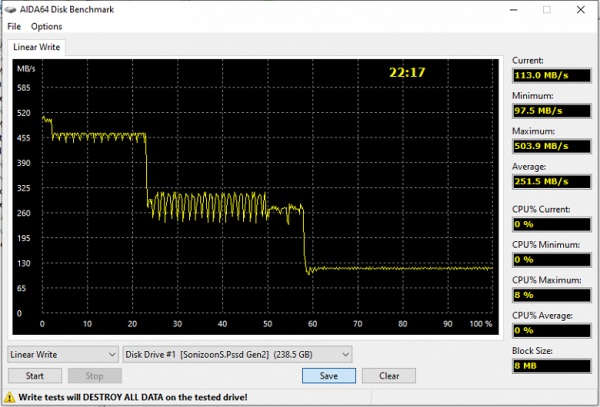
Sonyzoon, in fact, is not an ordinary flash drive, but is a full-fledged SSD on a Maxio MAS1102 controller, which is connected via a USB bridge. Overall it performs well, even reaching speeds of up to 500 MB/s, but this only occurs in the static part of the SLC cache. The interesting thing is that in this test its speed is only slightly higher than DM and even Transcend, despite having half the capacity.
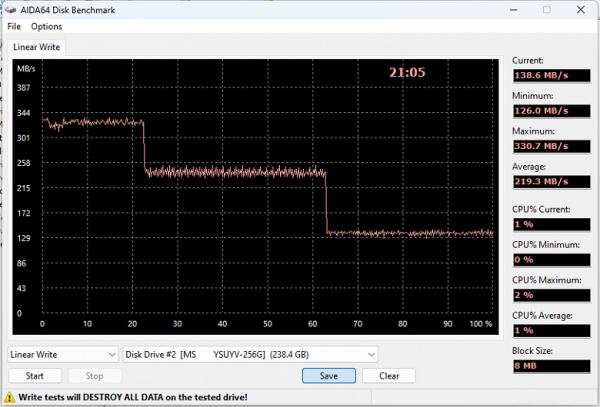
Interestingly, drives with a USB-UFS interface also exhibit similar behavior, provided Trim is operating normally. In such cases, the peak speeds are slightly lower, but the minimum speed remains above 100 MB/s (which the Sonyzoon with its 256 GB is not always able to achieve). As a result, the task completion time is comparable or even slightly shorter. This is why it has been said that UFS drives are liked even more than some budget external SSDs, especially those that use QLC memory.
However, when working at the file level, it is not always possible to repeat the results of low-level tests, including AIDA64. Buyers purchase such devices primarily for working with files, and not for conducting benchmarks. Therefore, we move on to the main part of testing.
Working with large files
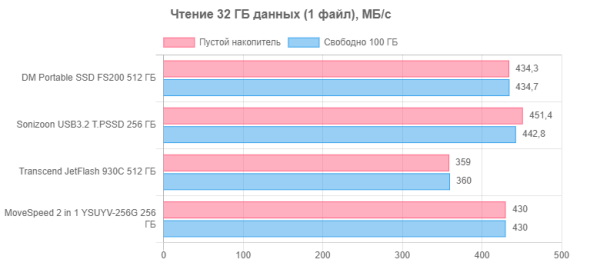
In its class, the Transcend JetFlash 930C is still considered a fast flash drive, but it doesn't reach USB 3.0 speeds like some other devices. UFS drives approach this limit, and external SSDs in compact designs even slightly exceed it. Perhaps it could be even faster, but for a drive with a capacity of 256 GB of TLC memory in single-threaded mode, this is too difficult a task.

However, if we are talking about multi-threaded reading (although this is rarely the case in practice), then Sonyzoon is limited only to the SATA interface internally, and USB-UFS is not able to exceed the capabilities of USB 3.0. However, flash drives usually do not reach such speed levels — even the fastest of them.

As has already been mentioned many times, high write speeds with low capacity SSDs on TLC and QLC memory are achieved thanks to SLC caching. This technology is fully functional in Sonyzoon and MoveSpeed, which allows them to outperform other devices. However, the peak superiority decreases significantly when the amount of free space becomes small. Both devices reserve about 20% of free memory for cache, so if there is not enough free space, the file will no longer fit into the cache. This is even more noticeable in the case of the DM FS200, which maintains a stable 200 MB/s, since its caching does not fully work. However, there is a solution to this problem — if you need to transfer large amounts of data, then it is better to choose an SSD of at least half a terabyte. This guarantees more stable operation and high speeds. If your budget is limited, you will have to put up with less capacity and possible speed drops. Ultimately, even flash drives that were once considered very fast are still significantly slower.

Multithreaded recording is usually not in favor of hard drives, just like multithreading in general. However, SSDs can increase or at least not decrease speed in this mode. But today this does not change the balance of power. UFS is a form of SSD: it is designed for highly mobile devices such as phones. Performance is limited by the bridge and may be further reduced due to device internals, but the operating principles remain the same.
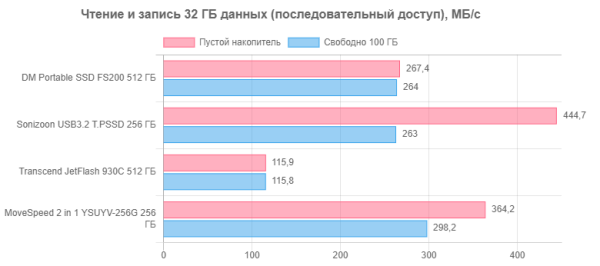
At first glance (and given our current test scenario) this may seem a bit artificial. However, in practice this is not the case: a similar load occurs, for example, when unpacking a large archive directly on a flash drive. But all of the above is true. Moreover, the situation is a little worse for modern budget SSDs and their SLC caching. This is especially critical with low capacity.
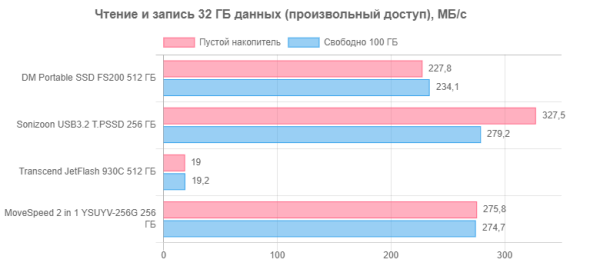
To better understand the results, let's remember once again that UFS is just an SSD, but designed for mobile devices. However, the requirements for their storage have long been no different from those usual for large computers. On the other hand, flash controllers of this level have not had such stringent requirements for a long time. But as mentioned earlier, the new controllers could be game-changers, although they still need to prove themselves to be effective. In the case of USB-UFS, the situation is more or less clear.
Comprehensive performance
At the moment, PCMark 10 Storage is considered the best comprehensive benchmark for assessing storage performance. This tool includes three tests, but not all are equally useful. The most informative is the «Full System Drive» test, which covers a wide range of usage scenarios, from loading the operating system to copying data. The remaining tests are only subsets of «Full System Drive» and are less interesting to our eyes. PCMark 10 Storage allows you to accurately measure not only drive throughput, but also latency when performing various tasks. Although averaging results and some degree of syntheticity are present, this is still the best way to get an overall assessment of performance. Even for external SSDs that can be used as a replacement for internal drives, PCMark 10 Storage may be overkill. However, fast models with sufficient capacity may be suitable for use with Windows To Go.
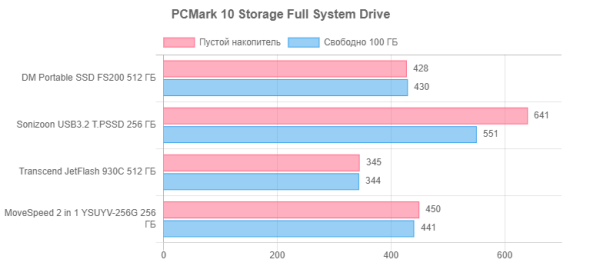
There is nothing surprising. Modern SSDs, which do not necessarily have a large capacity, are ideal for such use. USB-UFS is a little worse suited for this purpose. However, even high-end flash drives released three or four years ago still provide a good level of performance — significantly higher than external hard drives, for example.
Total
The purchase did not quite meet the expectations described in the advertisement, and the device does not function as stated by the manufacturer. However, this is a typical situation for AliExpress. There you can find interesting and useful products at low prices, but you need to be prepared to take some risks and have an idea of what exactly you are buying. In this case, although the device's performance was above average, some aspects were not up to par.
This testing was useful for several reasons. Firstly, it turned out that the lack of support for the Trim command in many of these devices is a consequence of the negligence of the programmers. Secondly, the operation of SLC caching was studied, which helps hide memory shortcomings and provide higher performance. For example, a 256 GB flash drive with a properly working cache can outperform a 512 GB flash drive that does not have caching implemented correctly.
Despite some advantages of USB-UFS drives, they are no longer the best solutions on the market. Among competitors, devices have appeared that can provide higher data transfer rates. And although these drives have their advantages, there are now more attractive options available in brick-and-mortar stores.


